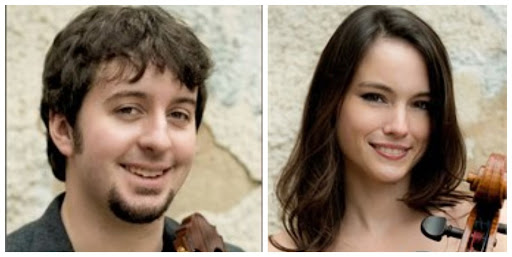by Mike Telin

With the spring sunshine flowing through the windows of the Cleveland Institute of Music’s Mixon Hall, the Duo led listeners down a path of musical delights drawn from the late 20th and 21st centuries.
The program began with two movements from Mathias Duplessy’s Sonata for Guitar and Cello in Four Dreams. The first, “Rêve Exalté,” is a continuous flow of undulating lines, while “Rêve Heureux” takes on a more relaxed feeling. Throughout, the playing was effortless.
Turning to the music of Brazilian guitarist Jamie Zenamon, the players brilliantly captured the contrasting moods of the sorrowful “Doloroso” and the spirited “Vivissimo” from Reflexões No. 6.
Welsh composer Stephen Goss’ Motherlands was inspired by its commissioners, who asked for a piece that reflected their individual roots. In his composer notes Goss writes that the piece is about migration and nostalgia. Sutton told the audience that although the work was written for soprano saxophone and guitar, he convinced his composer friend to make an arrangement for cello.
It was mostly played without pause, beginning with Patterson’s evocative interpretation of the “Incantation” before Sutton joined during “Roah Veroh.” Following the contemplative “Hymn” came “Kosichka,” a spirited dance, “Motherless Child,” a mesmerizing homage to the spiritual, and “Beirut,” a fast dance full of unison technical passages that the players tossed off with aplomb.
After intermission the Duo returned to the music of Stephen Goss, this time for his imaginative Still Life. Movements one, three, five, and seven are inspired by the paintings of the abstract expressionist Clyfford Still, while movements two, four, and six serve as interludes. From beginning to end, the piece is a progression from dark to light.
“PH-929, 1974 (Black)” and “Groove” showcase an engaging juxtaposition of slow, sustained notes in the cello and fast jazzy licks in the guitar. “PH-247, 1951 (Blue)” and “Scherzo” move into “PH-960, 1960) (Space),” which presents itself like a large blank canvas. Following “Albion,” the music of “PH-972, 1959 (Color)” takes listeners into the unknown. Throughout, the Patterson-Sutton Duo paid close attention to the work’s many subtle nuances.
The concert concluded with an inspired performance of a staple of the repertoire, Radames Gnattali’s Sonata for Cello and Guitar. An enjoyable ending to a performance you wished had gone on longer.
Published on ClevelandClassical.com June 13, 2023.
Click here for a printable copy of this article



